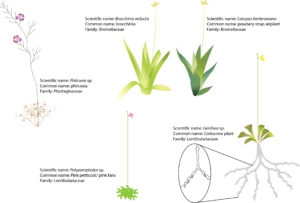
Under-discovered Carnivorous Plants
Besides the common carnivorous plants, there are many obscure carnivorous plants. Those under-discovered carnivorous plants are considered as protocarnivorous plants and sometimes referred to as paracarnivorous, subcarnivorous or borderline carnivores plants. Plant in this category is slightly different from carnivorous plants. Protocarnivorous plants can trap and kill insects or other small animals. But they do not digest the prey and absorb the nutrients from the victims due to the absence of digestive enzymes in the […]
Read More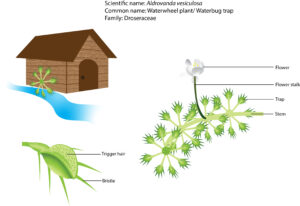
Aldrovanda vesiculosa, the waterwheel that is not powered by water
Utricularia is a semi-aquatic carnivorous plant that can grow in the terrestrial or aquatic environment. There is another exotic aquatic carnivorous plant, Aldrovanda vesiculosa. It is first observed in India in the sixteenth century. It is a true aquatic carnivore in the family of Droseraceae that is believed to be a direct relative of the Dionaea muscipula, the Venus flytrap due to its snap trap that is similar to that of Venus flytrap. They are […]
Read More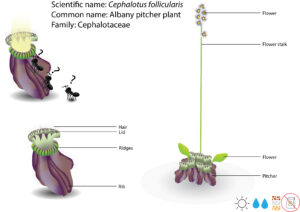
Cephalotus – the smallest pitcher plant
Background The smallest carnivorous pitcher is the west Australian pitcher plant, Cephalotus follicularis. It is one of the most desired carnivorous plants in the collection as well as cultivation. Cephalotus is a thumb-size pitcher of compact growth up to two inches long with colorful and bristly pitchers that are seemingly yawning for a bite to eat. It is a monotypic genus under the family of Cephalotaceae that is commonly referred to as the Albany pitcher […]
Read More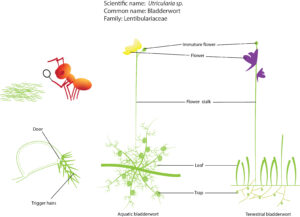
Utricularia – the smallest but fastest carnivorous plant
There is the various size of the carnivorous plant, but there is a carnivorous plant that does not look like one due to its tiny size and hidden preying mechanism. This species of Utricularia is under the family of Lentibulariaceae and native to North America. Commonly known as bladderworts, it was virtually unknown except to specialists such as aquarium hobbyists due to several reasons. They are always found in very wet areas or in the […]
Read More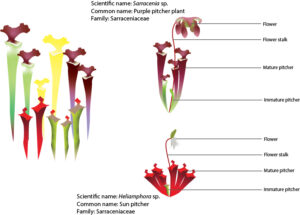
Pitcher plants – the “reed pipe” in nature
Background Pitcher plants are scattered around the world. Apart from Nepenthes and Darlingtonia, there are two more pitchers with different genus that are generally known as the American pitcher plants. Namely, Sarracenia and Heliamphora that both under the family of Sarraceniaceae. They are referred to as passive carnivores in which they use a passive preying mechanism that solely relies on the nectar and color or pigmentation of the modified leaves without any structural movements of […]
Read More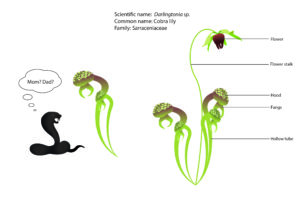
Darlingtonia, the cobra in carnivorous plants
Background Darlingtonia is commonly known as cobra lily due to its startling and special morphological structures. It is dicots, asterids, and found under the family of Sarraceniaceae. Obviously, Darlingtonia is very closely related to Sarracenia which is an allied genus known as trumpet pitchers that is indigenous to the eastern coast of the USA. It is so special with its bulbous green or red heads with a twisted colorful tongue that looks exactly like a cobra. […]
Read More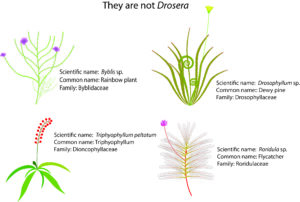
Carnivorous plants that look like Drosera
Well, we heard of sundew, the Drosera, when the dew is shined by light, it produces a mini rainbow. Why does it not called a rainbow plant? This is because the rainbow plant, the common name, is taken by Byblis under the family of Byblidaceae that is native to Australia. Byblis can appear as frosted sprays of water and sparkle with multicolored hues in the presence of light. It is not a sundew but it […]
Read More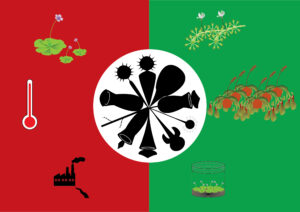
An imagination story: an introduction of carnivorous plants
Plants are mostly autotrophic that produce food by photosynthesis from inorganic raw material like sunlight and carbon dioxide. However, there is a very special group of plants that evolved in a unique way that they obtain nutrients through trapping animals. Unlike parasite plants who are unable to photosynthesis, carnivorous plants are capable of making their own food by photosynthesis and meanwhile capable of eating animals. As sessile and passive forms of life, how do carnivorous […]
Read More